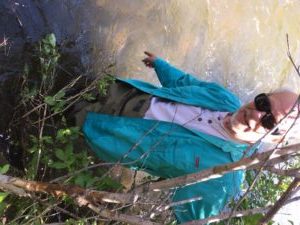Join us "behind the fin" with TU volunteer Duncan Rose from the Dolores watershed. How long have you been a TU member?
9-10 years - about three years in Charlotte, and seven here in Colorado.
Why did you become a member and what chapter are you involved with?
Dolores River Anglers, Chapter 145, here in the Four Corners of southwestern Colorado. As newbies to the area, I sought insight and orientation to the area from local enthusiasts.
What made you want to become involved with TU?
When we moved here I was approaching retirement and had targeted environmental organizations and fly fishing as a focal point of interest as I moved into retirement. TU, of course, combined both into an effective package.
What is your favorite activity or project you have done with TU?

Our recent study of climate change and its likely impacts on our home waters (we set out to identify and map long term trout strongholds in our mountains). While fishing in late summer of 2012 and 2013 (severe drought years here), several of us had noted cutties struggling through water only half their height to move from tiny pocket to tiny pocket. Being on the Western Slope, our waters are at the interface of high desert with big mountains. That makes us “canaries in the mine” with respect to climate change. Our findings reveal huge challenges for the persistence of trout habitat in the western San Juans by the turn of the century. We worked hard to make the study highly credible. Over 3000 hours of volunteer"citizen-science" was involved (along with $25,000 in various grants -- including chapter money and TU Gomo and Embrace a Stream grants-- for scientific expertise).
I know you won’t tell me your favorite spot, but what is your second favorite place to fish or favorite fishing story?
We have some 300 miles of trout habitat spread across 46 streams (1430 square miles of watershed) here in the upper Dolores. I’m particularly attracted to high, small, back-country tributaries, dry flies and, for the last four seasons, tenkara. The settings are as compelling as the fishing. I go out every week from runoff moderation to ice-out in November.

What does being a part of TU mean to you?
Besides the camaraderie of colleagues, as past chapter president and current conservation co-chair, I get to pay back some of the great enjoyment I derive from the fly fishing through our conservation projects. Which means that I am investing in a trout future for our two daughters.
What else do you do in your spare time or work?
I am on the board of our local Conservation Land Trust. We have just been “gifted” an 80 hay/cattle tract into which we are incorporating a significant agriculture education program for the greater region. TU and land conservation, great combination--both get under your skin and into your soul.
Editor' Note: The 'climate change study' referenced above is called: "Climate Change and the Upper Dolores Watershed: A Coldwater-fisheries Adaptive Management Framework"







